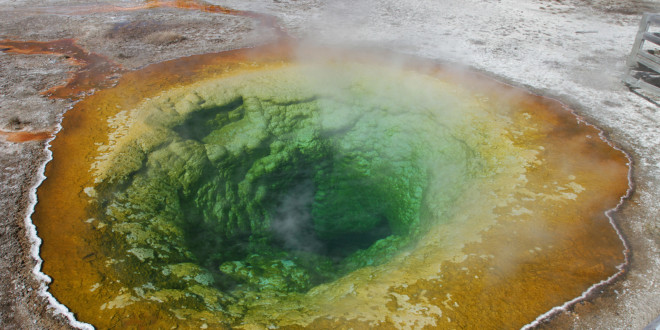Researchers from Arizona State and Montana State Universities are studying Yellowstone microbes to understand how they survive in the park’s hot springs.
In particular, one ASU researcher (ASU geoscientist Everett Shock) is pondering why at least one Yellowstone microbe eats so poorly and yet thrives.
Yellowstone microbes are a hot commodity in the microbiology world. Since they live and thrive in some of the harshest conditions on Earth, studying them provides valuable insights into habitability and adaptability.
According to ASU Now, the microbe in question is challenging conventional wisdom with regards to how microbes choose food sources:
“The team isolated this organism, which is a member of the Acidianus genus, from a hot spring in Yellowstone National Park and cultured it in the laboratory,” he said. “There it was given a choice of three different geochemical energy supplies.”
This microbe, Shock said, can get energy from combining hydrogen with sulfur, or hydrogen with iron, or sulfur with iron. In the experiments the team carried out, hydrogen and sulfur supplied the least energy, while hydrogen and iron provided the most.
“Surprisingly, the organism grew best on the lowest energy supply — and it grew the worst with the richest energy material,” Shock said.
The scientists’ report was published July 3 in Nature Geoscience. The lead author is Maximiliano Amenabar of Montana State University; besides Shock, the other authors are Eric Roden (University of Wisconsin), and John Peters and Eric Boyd (both Montana State).
[…]
“The results were quite counterintuitive,” said Shock. “It’s only natural to expect that in any environment, the ‘big deal’ energy sources will be supporting the most organisms, and the feeble sources — well, you wonder if they are supporting anything at all.”
It turns out, he explained, that in a genetic sense, it may be costly for the organism to go after the big-energy supply.
“It’s like mining,” he said. “You can have a rich ore deposit, but if extracting it costs more than you can get for it, it’s not worth pursuing.”
And in microorganism terms, Shock said, “biological cost may come down to availability. Perhaps the low-energy source is more reliable in nature than the high-energy one.”
Shock notes that the microbe was not averse to consuming other food sources, but chose to eat the more “reliable” source instead. Honing in on “reliability” instead of innate quality could help researchers unlock why certain microbes behave as they do. Indeed, Shock notes that learning “why this organism thrives best on low-energy food sources” is the next task for researchers.
Although Yellowstone microbes have been studied for decades, in recent years, the study of said microbes has become even more high profile. Last summer, the Oak Ridge National Laboratory isolated, for the first time, a microbe found in Norris Geyser Basin’s Cistern Spring that researchers hope can be modified for a variety of uses.
In 2015, Berkley-based CinderBio announced they had extracted heat and acid resistant enzymes from Yellowstone microbes, which the firm hoped could be used to more efficiently, clean food manufacturing equipment.
Finally, in 2014, a Wisconsin medical firm sought to use enzymes derived from Yellowstone microbes as part of “a new portable Ebola diagnostic tool.”
 Yellowstone Insider Your Complete Guide to America's First National Park
Yellowstone Insider Your Complete Guide to America's First National Park





